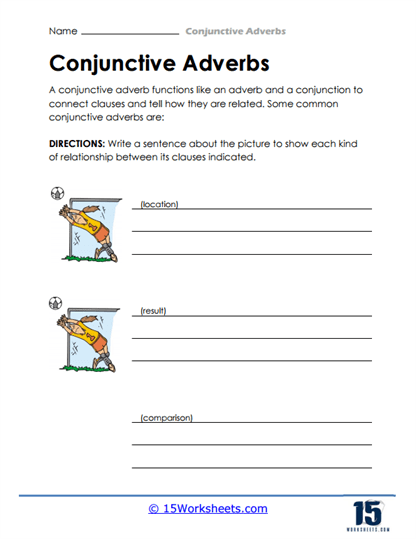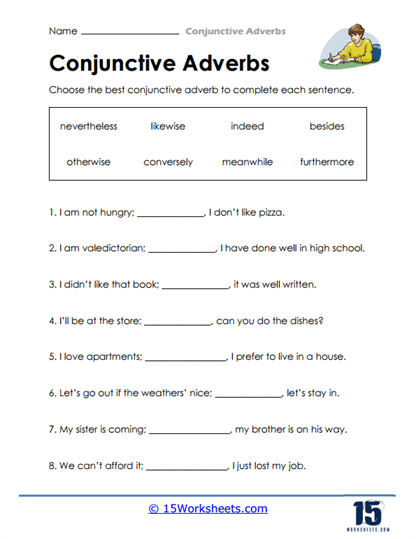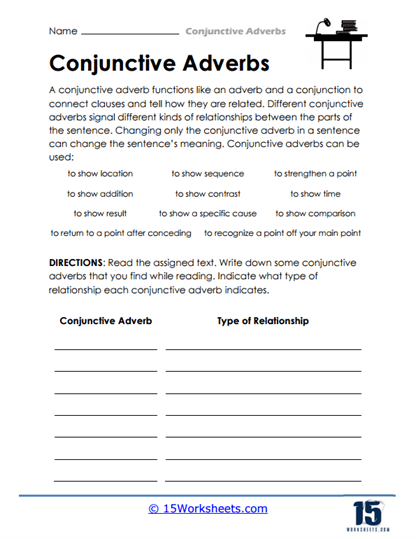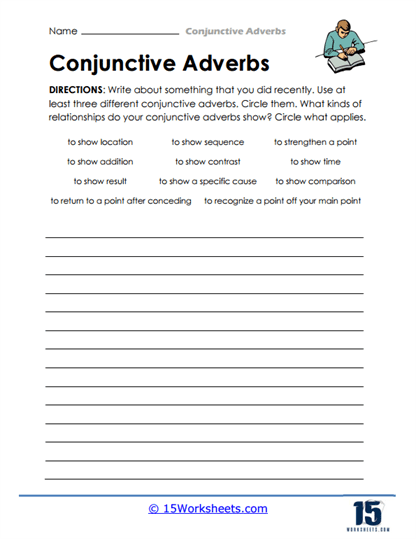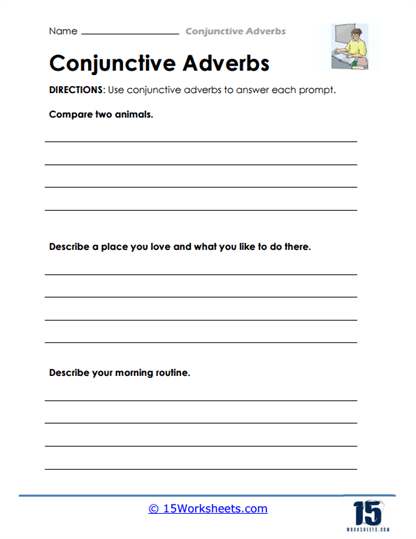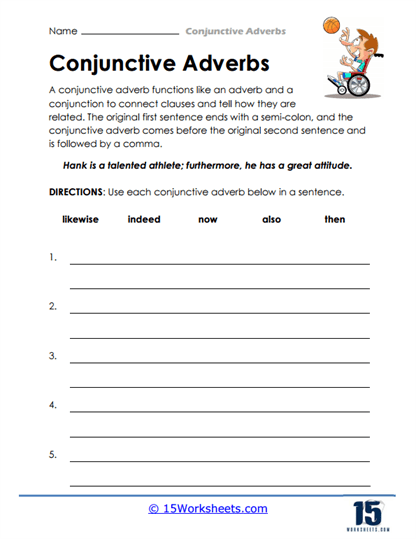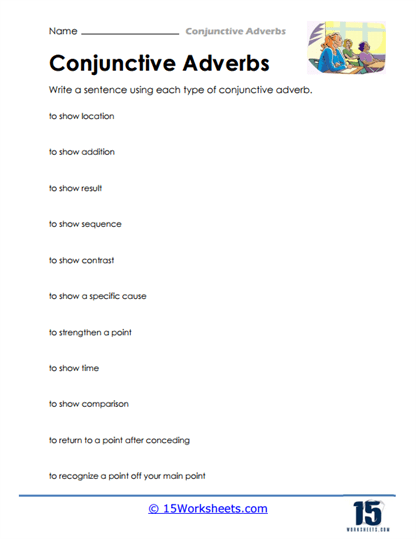Conjunctive Adverbs Worksheets
About These 15 Worksheets
Conjunctive adverbs, such as “however,” “therefore,” and “meanwhile,” play a crucial role in helping students articulate more complex thoughts and ideas. These worksheets are thoughtfully crafted to provide a variety of exercises that cater to different learning styles, ensuring that all students can grasp the concept at their own pace.
Several of the worksheets focus on identifying conjunctive adverbs within sentences. Students are prompted to read each sentence carefully and underline the conjunctive adverb, fostering close reading and comprehension skills. This exercise is an excellent way for students to recognize these adverbs in context, reinforcing their understanding of how these words function to link ideas.
Another type of worksheet in this collection encourages students to choose the appropriate conjunctive adverb to complete a sentence. This activity not only tests their knowledge but also enhances their critical thinking as they decide which adverb best fits the sentence’s meaning. By practicing this, students learn to consider context and nuance, which are key components of effective writing.
Some worksheets challenge students to fill in blanks with suitable conjunctive adverbs from a provided list. This exercise is particularly useful for reinforcing vocabulary and ensuring that students can accurately apply these adverbs in various contexts. These worksheets help in transitioning students from recognizing conjunctive adverbs to using them actively in their writing.
Sorting activities require students to categorize conjunctive adverbs based on their function, such as showing contrast, sequence, or addition. This task not only solidifies their understanding of each adverb’s role but also improves their ability to organize information logically-a skill that’s invaluable in writing and beyond.
For more advanced practice, the worksheets include exercises where students must join two independent clauses using a conjunctive adverb and the correct punctuation. This type of activity is perfect for teaching the intricacies of sentence structure, such as the use of semicolons and commas, which are often tricky for young writers to master. By working through these exercises, students develop a stronger grasp of how to create complex, well-punctuated sentences.
There are also creative writing prompts where students are encouraged to use conjunctive adverbs to enhance their descriptive writing. These prompts are designed to make writing more engaging and to show students how these adverbs can bring clarity and cohesion to their narratives. Whether describing their morning routine or comparing two animals, students will see how conjunctive adverbs can add depth and flow to their writing.
In addition to these, reading comprehension worksheets are included where students must identify and analyze the use of conjunctive adverbs in context. This not only helps them see how these adverbs function in real-world texts but also enhances their ability to decode meaning and understand authorial intent.
The worksheets in this collection are available in PDF format, making them incredibly easy to view, download, and print. This convenience allows you to integrate them seamlessly into your curriculum, whether you’re teaching in a classroom or a homeschool setting. The PDFs are designed to be user-friendly, with clear instructions and well-organized content, ensuring that students can work through them independently or with minimal guidance.
These exercises are more than just drills; they’re a gateway to more confident, expressive, and polished writers. Your students will not only learn to recognize and use conjunctive adverbs but also understand how these words can transform their writing by linking ideas and creating sophisticated sentence structures.
As a teacher, I’ve seen the difference these worksheets can make in a student’s writing journey. They encourage a deeper understanding of language mechanics and help students to become more thoughtful and deliberate in their writing. Whether your students are just beginning to explore complex sentences or need additional practice to refine their skills, this collection of Conjunctive Adverbs Worksheets is an invaluable resource that will support their learning every step of the way.
Engage your students with these varied and thoughtfully designed worksheets, and watch as their writing blossoms into something truly remarkable. The confidence they gain from mastering conjunctive adverbs will extend beyond grammar, giving them the tools they need to express themselves clearly and effectively in all areas of their academic life.
What Are Conjunctive Adverbs?
Conjunctive adverbs are words that function as both adverbs and conjunctions, playing a crucial role in linking ideas between two independent clauses within a sentence. These words, such as “however,” “therefore,” “meanwhile,” and “consequently,” serve to illustrate relationships like contrast, cause and effect, sequence, or addition between the connected clauses. When using conjunctive adverbs, it is important to follow specific grammatical rules to ensure clarity and proper sentence structure. Typically, when a conjunctive adverb connects two independent clauses, a semicolon is placed before the conjunctive adverb, followed by a comma after it. For instance, in the sentence “The weather was terrible; however, we decided to go hiking,” the semicolon before “however” and the comma after it help to clearly link the two related, but distinct ideas. Conjunctive adverbs can also appear at the beginning or within a single clause to add emphasis or transition between ideas, in which case they are followed by a comma. Understanding and using conjunctive adverbs correctly allows writers to create more complex, cohesive, and fluid sentences that effectively convey the relationships between ideas.









